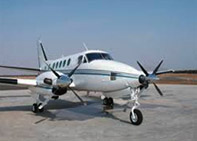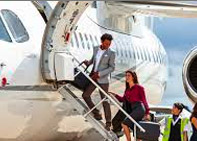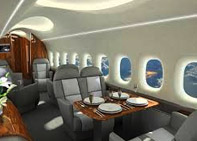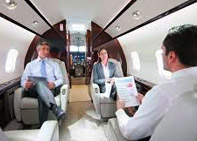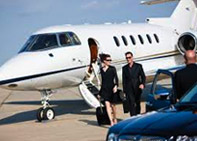Glossary of Air Charter related terms
- A
- Air Charter Air Charter Services provide a travel system in which users rent a whole plane to perform private trips according to their particular needs. The difference with regular Airline seats - even with first class seats- is that the Air Charter Service companies provide the exact conditions that the users need: departure time, itinerary, cargo transportation, aeroplane type, etc. It has been becoming increasinly popular since the late 1990s due to the acceleration and competitiveness effects generated by business globalization.
- Aircraft Type
Aircraft types are categorized according to the propulsion method the use.
See Piston Aircraft, Turbo Aircraft - C
- Cargo Cargo is the ammount of goods or physical objects that are carried by a particular aeroplane.
- Charter
A charter is contract to hire or lease transportation.
See Air charter - K
- Knot The knot is a unit of speed equal to exactly 1.852 km/h and approximately 1.151 mph. Used abbreviationis are kn, kt (singular) and kts (plural).
- P
- Payload Payload is the sum of the weight of the passengers and cargo carried by an aeroplane. The payload weight is inversely related with the maximum range of the aeroplane: the more payload weight the less maximum range.
- Piston (propelled) Aircraft
Piston Airfcrafts refer to the type of propulsion used by the aeroplane's engine. Piston engines are heat engines that use one or more reciprocating pistons to convert pressure into a rotating motion.
They are most suitable for short-range trips in good weather conditions. Being generally smaller than other types of aeroplane passangers and cargo transport capabilities are reduced.
Most popular models are: Beech Baron 55, Beech 58 Baron, Beech Duchess 76, Cessna 414, Cessna 340, Cessna 421 C, Cessna 402, Cessna Skylane 210, Partenavia PN-68, Piper Cherokee Six, Piper Navajo/Chieftain, Piper PA-34, DA 42 Diamond Twin Star
A.K.A. pistonprop, reciprocating engine.
more: http://en.wikipedia.org/wiki/Piston_engine - Pistonprop See Piston (propelled) Aircraft
- R
- Range An aircraft range is the distance it can flight without re-fuelling.
- T
- Turbo/ turbine (propelled) Aircraft
Turbo aircrafts or Turboprops are aircrafts that use gas turbine engine for propulsion. Gas turbine engines consist of an intake, compressor, combustor, turbine, and a propelling nozzle. Most of the energy produced by the combustion of fuel-air is used to drive the propeller fan.
Turboprops are very efficient at moderate flight speeds, below 450 mph. The is a very wide range of turboprop models but they are generally suitable for short and medium range trips. Passanger capacities vary from 2 to 70.
Most popular models are: ATR-42, ATR-72, Beech King Air 100, Beech 1900, Beech King Air 200, Beech King Air 300, Beech King Air 350, Casa 212-200, Dash 8-100, Dornier 228, Dornier 328, Embraer Bandeirante, Embraer 120 Brasilia, Embraer 121 Xingu, Fokker F27-100, Fokker F27-200, Fokker 50, Jetstream 61 ATP, Jetstream 41, Jetstream 31, Merlin II, Metro III, Mitsubishi MU-2, Piaggio Avanti P.180, Piper Cheyenne, SAAB 2000, SAAB SF-340, Shorts SD360, Turbo Commander
A.K.A. turboprops
more: http://en.wikipedia.org/wiki/Turboprop - Turboprop See Turbo/ turbine (propelled) Aircraft
- U
- Useful load Useful load is the total weight that can be transported by a particular aeroplane. It is the sum of the weight of the passengers, crew, fuel, oil and payload.

